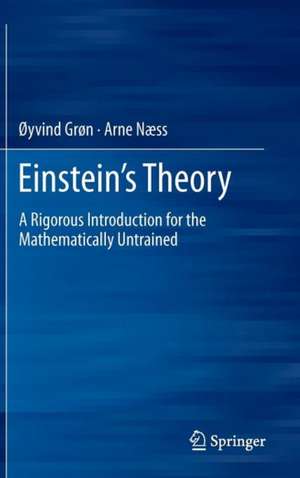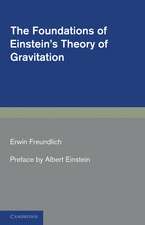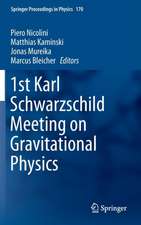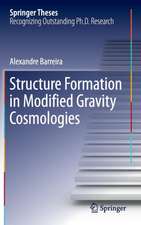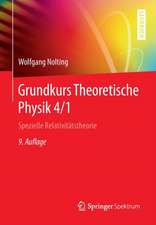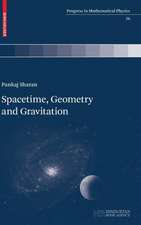Einstein's Theory: A Rigorous Introduction for the Mathematically Untrained
Autor Øyvind Grøn, Arne Næssen Limba Engleză Hardback – 30 aug 2011
First, the book starts at a lower mathematical level than standard books with tensor calculus of sufficient maturity to make it possible to give detailed calculations of relativistic predictions of practical experiments. Self-contained introductions are given, for example vector calculus, differential calculus and integrations. Second, in-between calculations have been included, making it possible for the non-technical reader to follow step-by-step calculations. Thirdly, the conceptual development is gradual and rigorous in order to provide the inexperienced reader with a philosophically satisfying understanding of the theory.
The goal of this book is to provide the reader with a sound conceptual understanding of both the special and general theories of relativity, and gain an insight into how the mathematics of the theory can be utilized to calculate relativistic effects.
| Toate formatele și edițiile | Preț | Express |
|---|---|---|
| Paperback (1) | 587.02 lei 6-8 săpt. | |
| Springer – 7 oct 2014 | 587.02 lei 6-8 săpt. | |
| Hardback (1) | 593.42 lei 6-8 săpt. | |
| Springer – 30 aug 2011 | 593.42 lei 6-8 săpt. |
Preț: 593.42 lei
Preț vechi: 698.13 lei
-15% Nou
Puncte Express: 890
Preț estimativ în valută:
113.55€ • 118.55$ • 93.98£
113.55€ • 118.55$ • 93.98£
Carte tipărită la comandă
Livrare economică 05-19 aprilie
Preluare comenzi: 021 569.72.76
Specificații
ISBN-13: 9781461407058
ISBN-10: 1461407052
Pagini: 360
Ilustrații: XVII, 341 p.
Dimensiuni: 155 x 235 x 25 mm
Greutate: 0.68 kg
Ediția:2011
Editura: Springer
Colecția Springer
Locul publicării:New York, NY, United States
ISBN-10: 1461407052
Pagini: 360
Ilustrații: XVII, 341 p.
Dimensiuni: 155 x 235 x 25 mm
Greutate: 0.68 kg
Ediția:2011
Editura: Springer
Colecția Springer
Locul publicării:New York, NY, United States
Public țintă
ResearchCuprins
Vectors.- Differential calculus.- Tangent vectors.- Curvilinear coordinate systems.- The metric tensor.- The Christoffel symbols.- Covariant differentiation.- Geodesics.- Curvature.- Conservation laws of classical mechanics.- Einstein’s field equations.- Einstein’s theory of spacetime and gravitation.- Some applications.- Relativistic universe models.
Recenzii
From the reviews:
“Einstein’s Theory fits in an unusual place for introductory books on the topic. … this work reaches the mathematical, theoretical, and conceptual understanding of a graduate course, assuming just basic algebraic skills. … this is a rare book that can take the motivated reader with an elementary algebra background to a rigorous understanding of general relativity. Summing Up: Recommended. Lower-division undergraduates and general readers.” (E. Kincanon, Choice, Vol. 49 (9), May, 2012)
“This book stands apart from other introductory textbooks on general relativity in that it is aimed at non-science educated readers who nonetheless want to get a thorough understanding of this theory. … The book succeeds quite well in explaining the concepts underlying general relativity in elementary terms without sacrificing mathematical rigor. An additional bonus are the philosophical remarks obviously due to one of the authors being a philosopher himself.” (Helmut Rumpf, Zentralblatt MATH, Vol. 1234, 2012)
“Einstein’s Theory fits in an unusual place for introductory books on the topic. … this work reaches the mathematical, theoretical, and conceptual understanding of a graduate course, assuming just basic algebraic skills. … this is a rare book that can take the motivated reader with an elementary algebra background to a rigorous understanding of general relativity. Summing Up: Recommended. Lower-division undergraduates and general readers.” (E. Kincanon, Choice, Vol. 49 (9), May, 2012)
“This book stands apart from other introductory textbooks on general relativity in that it is aimed at non-science educated readers who nonetheless want to get a thorough understanding of this theory. … The book succeeds quite well in explaining the concepts underlying general relativity in elementary terms without sacrificing mathematical rigor. An additional bonus are the philosophical remarks obviously due to one of the authors being a philosopher himself.” (Helmut Rumpf, Zentralblatt MATH, Vol. 1234, 2012)
Notă biografică
Øyvind Grøn, Oslo University College, Oslo, Norway, oyvind.gron@fys.uio.no
Arne Næss, Oslo University College, Oslo, Norway (deceased)
Arne Næss, Oslo University College, Oslo, Norway (deceased)
Textul de pe ultima copertă
This book provides an introduction to the theory of relativity and the mathematics used in its processes. Three elements of the book make it stand apart from previously published books on the theory of relativity.
First, the book starts at a lower mathematical level than standard books with tensor calculus of sufficient maturity to make it possible to give detailed calculations of relativistic predictions of practical experiments. Self-contained introductions are given, for example vector calculus, differential calculus and integrations. Second, in-between calculations have been included, making it possible for the non-technical reader to follow step-by-step calculations. Thirdly, the conceptual development is gradual and rigorous in order to provide the inexperienced reader with a philosophically satisfying understanding of the theory.
Einstein's Theory: A Rigorous Introduction for the Mathematically Untrained aims to provide the reader with a sound conceptual understanding of both the special and general theories of relativity, and gain an insight into how the mathematics of the theory can be utilized to calculate relativistic effects.
First, the book starts at a lower mathematical level than standard books with tensor calculus of sufficient maturity to make it possible to give detailed calculations of relativistic predictions of practical experiments. Self-contained introductions are given, for example vector calculus, differential calculus and integrations. Second, in-between calculations have been included, making it possible for the non-technical reader to follow step-by-step calculations. Thirdly, the conceptual development is gradual and rigorous in order to provide the inexperienced reader with a philosophically satisfying understanding of the theory.
Einstein's Theory: A Rigorous Introduction for the Mathematically Untrained aims to provide the reader with a sound conceptual understanding of both the special and general theories of relativity, and gain an insight into how the mathematics of the theory can be utilized to calculate relativistic effects.
Caracteristici
Covers both special and general theory of relativity and applications to cosmology in a logical and self-contained way Provides the reader with a philosophically satisfying understanding of Einstein’s theory Presents both the conceptual and working knowledge of Einstein’s theory, without the reader having to make his own calculations Includes supplementary material: sn.pub/extras
